11 Of The Unhealthiest Items At Panda Express

Panda Express has won over countless fans with popular dishes like Orange Chicken, Beijing Beef, and Chow Mein. But if you're watching your health, it's important to take a closer look at what's really in these well-loved meals. As more and more people are taking up healthier eating habits, being aware of the nutritional makeup of these popular dishes is essential. It raises a pressing question: How can we navigate the tempting Panda Express menu to find choices that won't derail our health goals?
Many of these meals are packed with a high number of calories in a small serving size, making it easy to go overboard on your daily calorie intake. This is often paired with a significant amount of fats, including less healthy saturated and trans fats. Another concern is the high sodium content in many dishes, which could lead to long-term heart issues with regular consumption. Additionally, the frequent use of refined carbohydrates and the low fiber content can lead to unstable blood sugar levels and compromised digestive health. Despite their hearty appearance, these meals often fall short of providing enough protein for a balanced diet. Plus, there are artificial additives and preservatives to be aware of.
Read more: The 15 Best Frozen Chicken Nuggets, Ranked
Orange Chicken

The Panda Express Orange Chicken -- 36 years old at the time of writing -- is a staple on the menu. It features crispy chunks of deep-fried, battered dark-meat chicken that are then tossed in a sweet, orange-flavored sauce. The dish contains high sugar, with 19 grams per serving, almost nearing the daily recommended limit of 25 grams for women and 36 grams for men, as per the American Heart Association guidelines. It also packs 490 calories in a relatively small 5.7-ounce serving size. Eating calorie-dense foods such as this can increase the risk of obesity if consumed in large quantities or frequently, as explained by the Mayo Clinic.
The dish uses dark meat, which is generally higher in fat compared to white meat. This is evidenced by its substantial fat content of 23 grams per serving, including 5 grams of saturated fat. The U.S. Food and Drug Administration's guideline for saturated fat pegs the daily value at less than 20 grams per day, of which one serving of Panda Express Orange Chicken takes up a big chunk.
Additionally, the inclusion of modified food starch and other similar additives in this dish indicates a lower nutritional quality than dishes made from whole ingredients. With only 2 grams of dietary fiber, the Orange Chicken doesn't contribute much to the daily requirement of fiber, which helps promote better digestion and prevent blood sugar spikes.
Beijing Beef
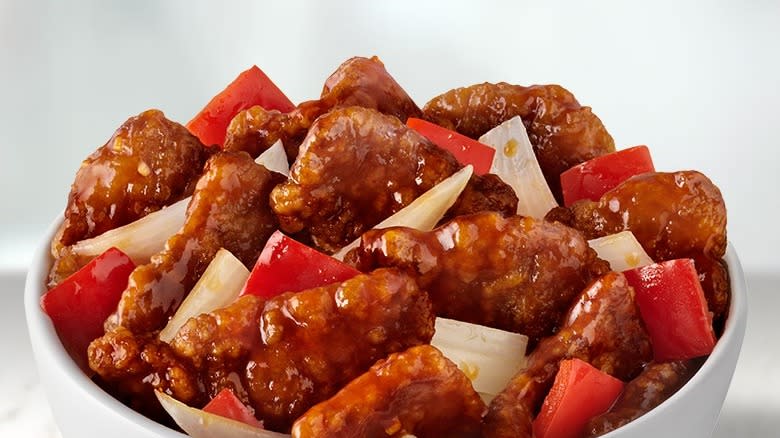
Introduced in 2008, Panda Express Beijing Beef marked a significant addition to the chain's menu. The dish consists of crispy beef strips that are wok-tossed with a tangy, sweet, and spicy sauce, served with red bell peppers and onions. A single serving of 5.6 ounces packs 480 calories, accounting for a significant portion of your daily caloric intake.
This menu item also has 21 grams of sugar. This amount is near the total recommended amount of daily sugar. It is also higher than the amount of sugar found in Orange Chicken. Also notable is the 27 grams of fat. This includes 5 grams of saturated fat, marking the highest in this list and making up about 25% of the daily value. This could pose potential health risks if consumed regularly without moderation. moderation.
The amount of sodium in this dish is also high. This dish contains around 600 milligrams, which is about a quarter of the daily recommended limit of 2,300 milligrams. Several preservatives and additives like phosphoric acid, potassium sorbate, and sodium benzoate are included, which could potentially have adverse effects in the long run. For instance, sodium benzoate has been linked to promoting inflammation and obesity, as reported by Healthline. Despite being a beef dish, its protein content is only moderate (14 grams), given the high-calorie count, which may limit its ability to make you feel full.
Honey Walnut Shrimp
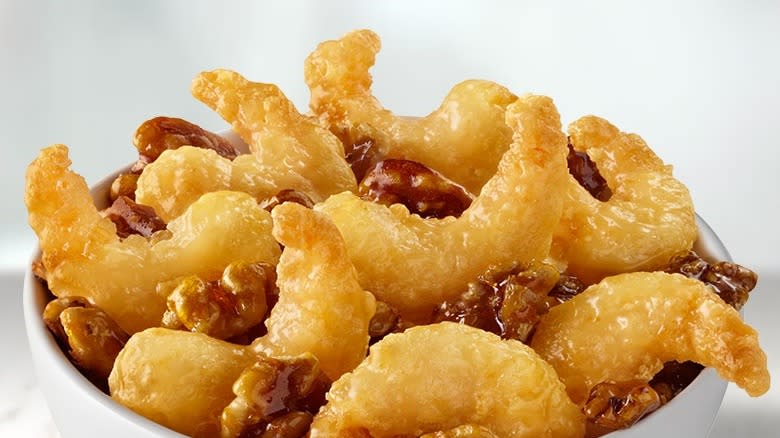
Panda Express Honey Walnut Shrimp consists of large, tempura-battered shrimp that are stir-fried with glazed walnuts and a unique sauce made with honey. Per 3.7-ounce serving, it contains 360 calories, 24 grams of fat -- of which 3.5 grams are saturated fat, and 590 milligrams of sodium (around 25% of the daily recommended value).
The dish contains added sugars, amounting to 8 grams per serving. The American Heart Association warns that regular intake of added sugars can increase the risk of chronic diseases such as obesity, type 2 diabetes, heart disease, and even certain cancers. It contains only 1 gram of dietary fiber. Additionally, it only has around 11 grams of protein despite being a seafood dish.
It includes the additive sodium tripolyphosphate, which may cause damage to the kidneys, according to Healthline. The ingredient list is also extensive, with many processed components, including soybean oil, a processed oil high in omega-6 fatty acids. In large quantities, these fatty acids can contribute to inflammation and other health issues, according to a 2018 study.
Sweetfire Chicken Breast

The Panda Express Sweetfire Chicken Breast is a dish of crispy, lightly breaded chicken breast bites combined with red bell peppers, onions, and pineapple chunks, all tossed together in a sweet and spicy sauce made from a blend of flavors, including red jalapenos and garlic.
This dish contains a high sugar content of 19 grams per serving. This amount nearly meets the recommended daily limit for adult women, which is 25 grams of sugar. This amount is considerable, especially for those monitoring their blood sugar levels. Plus, with only 2 grams of dietary fiber, the dish offers limited support for digestion.
The ingredient list includes bleached wheat flour and cornstarch, which are sources of refined carbohydrates. According to Healthline, refined carbohydrates can lead to spikes in blood sugar levels and offer less nutritional value than whole grains. This menu item is also made with modified food starch containing maltodextrin, which may trigger dermatological symptoms similar to allergic reactions, such as itching and rashes, as explained by Is It Bad For You.
Honey Sesame Chicken Breast

Panda Express Honey Sesame Chicken Breast features chicken breast strips cooked along with green beans and yellow bell peppers. The chicken and vegetables are then tossed in a honey sesame sauce, which is a mixture of water, sugar, organic honey, and spices. Sounds pretty healthy, right? However, it's not.
A serving of this dish, which is 5.3 ounces, contains 15 grams of total fat, significantly contributing to the daily recommended limit of 20 grams. Consuming so much fat can have a negative impact on heart health. Despite containing vegetables, this Panda Express dish only delivers 1 gram of fiber.
The batter includes wheat flour, a refined carbohydrate that may induce a spike in blood sugar levels. We also found caramel color on the ingredient list. Although it is widely used in the food industry, a 2013 study linked caramel color to the formation of carcinogenic substances during manufacturing.
Eggplant Tofu
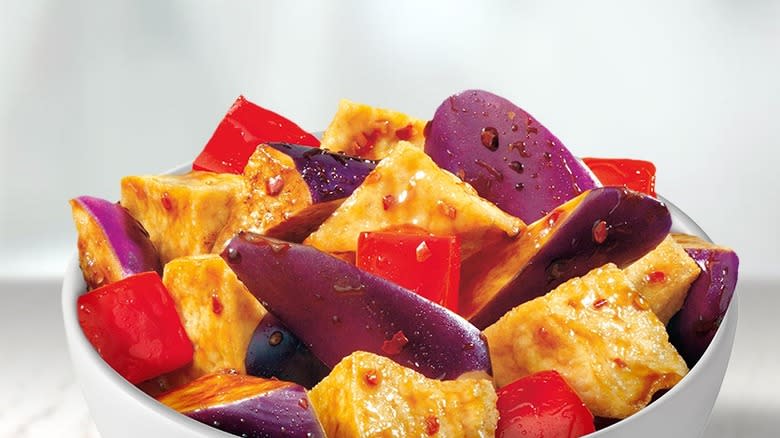
The Panda Express Eggplant Tofu is a vegetarian dish that features lightly browned tofu cubes and sliced eggplants stir-fried with red bell peppers and coated in a slightly spicy and sweet soy garlic sauce. The dish's health profile seems to be a mixed bag. On the one hand, it features wholesome main ingredients like eggplant, a great source of dietary fiber, vitamins, and minerals, and tofu, a known good source of protein. However, its nutrition facts only show 3 grams of fiber and 7 grams of protein, indicating that those sought-after macronutrients have been stripped away during preparation and cooking.
This dish also contains added sugars, found both in the general ingredients list and in the proprietary sauce, adding up to 17 grams in total. Moreover, the dish has multiple sources of starch: modified food starch, potato starch, and cornstarch, which increase the carbohydrate count. These elements can significantly affect those managing blood sugar levels or those trying to manage their weight while opting for a seemingly healthier option.
Another concern is the presence of soybean oil, which contains linoleic acid. As reported by ABC7, high consumption of linoleic acid has been studied to reduce beneficial gut bacteria and compromise colon health.
Chow Mein
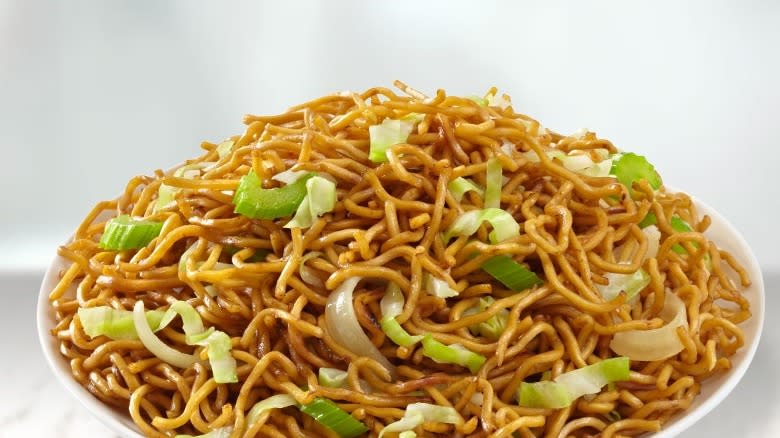
Chow mein, which translates to stir-fried noodles in Mandarin, is a staple side at Panda Express, much like the chain's fried rice. The chow mein consists of wheat noodles combined with cabbage, celery, and onions, all wok-tossed in a soy sauce-based seasoning. This dish is often one of the first items that greet you as you begin your order at a store.
As for its health content, a 9.4-ounce serving contains 510 calories, which is considerable, especially given that chow mein is categorized as a side dish. Moreover, it contains a high amount of sodium, about 860 milligrams, approximately 37% of the recommended daily intake of 2,300 milligrams. The proprietary stir-fry sauce in the chow mein lists sugar as a primary ingredient, contributing to the 9 grams of sugar per serving found in the dish.
The ingredient list includes artificial colors (Yellow 5 and Yellow 6). These are synthetic dyes that have been linked to various health issues, including allergies and hyperactivity in children, according to Healthline. Lastly, since it's wheat-based, this dish is not suitable for a gluten-free diet. It also contains 80 grams of carbohydrates. This is a substantial amount, particularly when consumed alongside other carb-rich items on the menu.
Fried Rice
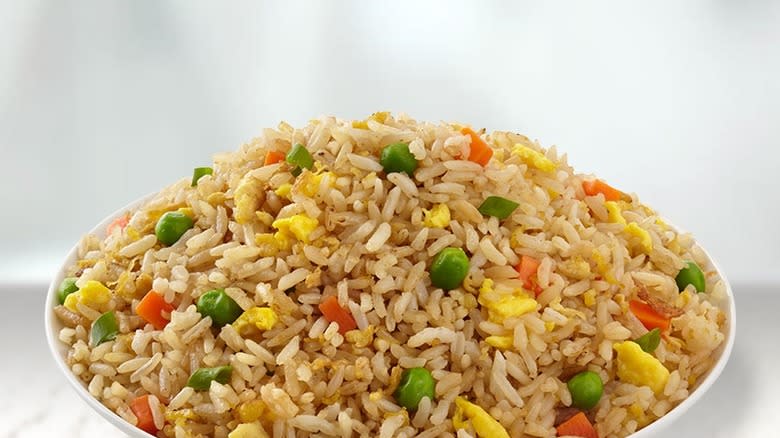
Panda Express Fried Rice is a widely favored side dish at the fast-food chain, often paired with chow mein in a half-and-half style order. The dish comprises steamed white rice that is stir-fried with a vibrant mixture of soy sauce, scrambled eggs, peas, carrots, and green onions.
This combination delivers 520 calories per serving, accounting for over 25% of a standard 2,000-calorie daily diet. Additionally, it contains 16 grams of total fat, inclusive of 3 grams of saturated fat, with the use of soybean and sesame oil further boosting the calorie and fat figures.
It mirrors chow mein's high sodium at 850 milligrams per serving. Made from white rice, it carries a substantial carbohydrate load of 85 grams per serving, unsuitable for individuals managing their blood sugar levels. This concern stems from the body's conversion of carbs into glucose, as noted by the American Diabetes Association. Despite its high carbs, it only offers 1 gram of fiber, which is beneficial for moderating sugar absorption. The stir-fry sauce, using sugar as its primary ingredient, also amplifies the overall sugar count.
Veggie Spring Roll
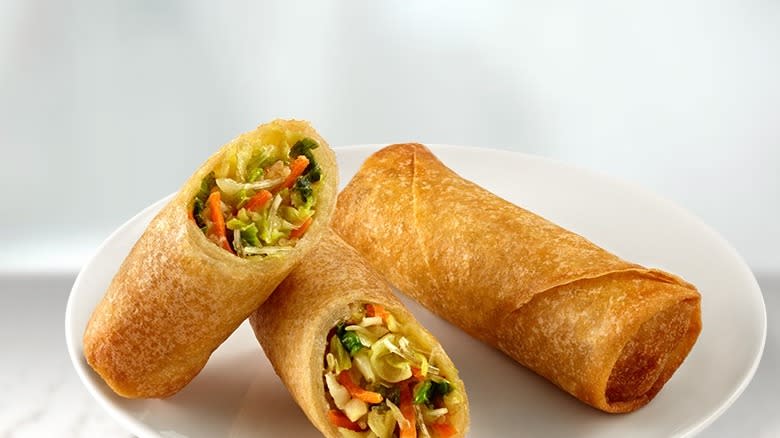
The Panda Express Veggie Spring Roll is a vegetarian appetizer that contains a mixture of cabbage, carrots, and celery wrapped in a wonton shell that's deep-fried until golden brown. The dish contains 14 grams of total fat (including 2 grams of saturated fat), a major contributor to the calorie content (130 out of 240 calories) for a serving of just two rolls. Despite the small size, it contains a high sodium level of 560 milligrams, which is about a quarter of the recommended daily sodium intake.
The list of ingredients includes disodium inosinate and disodium guanylate, which are commonly combined with MSG to produce an umami flavor. According to Allergy Link, consumption of these substances can potentially cause reactions, including behavioral problems in children, heart palpitations, migraine headaches, and mental confusion.
Additionally, we found monoglycerides and diglycerides in the ingredient list, substances known to be susceptible to contamination by toxins such as nickel, cadmium, and lead, according to Medical News Today. The use of wheat flour, which is likely refined, indicates the presence of gluten and simple carbohydrates that can quickly raise blood sugar levels.
Cream Cheese Rangoon

Three crispy wontons make up a serving of Panda Express Cream Cheese Rangoon, each filled with a mixture of cream cheese and green onions. Before being served, they are folded into a flower shape and deep-fried to a golden crisp. Despite its small 2.4-ounce serving size (comprising 3 pieces), it packs a substantial 190 calories, making it a concern for weight watchers. Also noteworthy is its 5 grams of saturated fat. According to the Mayo Clinic, a diet high in saturated fats can raise levels of "bad" cholesterol in the blood, a precursor to cardiovascular diseases.
Although the trans fat content is listed as zero, the ingredient list shows the inclusion of mono and diglycerides, which introduce trans fats. This raises additional health concerns, as trans fats are notorious for increasing the risk of obesity, stroke, and diabetes, according to My SuperHero Foods. Additionally, the use of enriched flour means refined carbohydrates are present.
The Cream Cheese Rangoon leaves much to be desired in terms of fiber and protein content, offering only 2 grams and 5 grams, respectively. As we know, fiber and protein aid in creating a sense of satiety, which helps in managing portion control.
Chicken Egg Roll
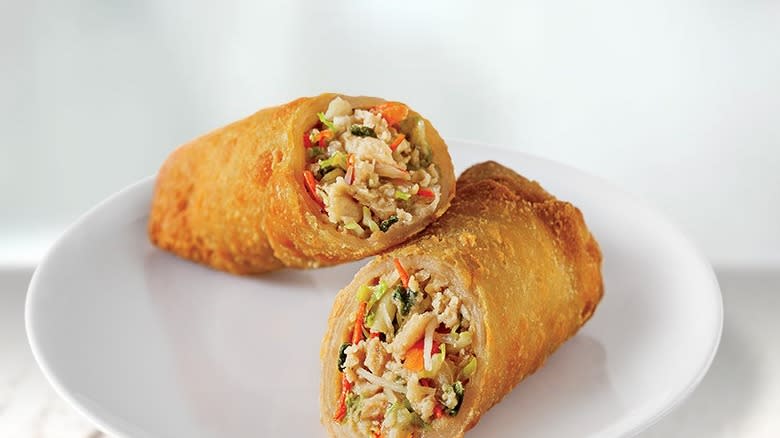
The Panda Express Chicken Egg Roll is another prominent appetizer from the chain. It consists of chicken, cabbage, carrots, onions, and a mix of spices, all wrapped in a wheat flour wrapper and then deep-fried until golden and crispy. It is often served with soy or sweet and sour sauce for dipping. Despite its small serving size of 2.75 ounces, it has several health concerns. First, it is high in fat, with 10 grams per serving, including 2 grams of saturated fat. Although not explicitly stated, the ingredient list suggests the potential presence of trace amounts of trans fats due to the inclusion of vegetable oil. According to the FDA, food manufacturers are allowed to list the amount of trans fat as zero if it's less than 0.5 grams.
Additionally, the egg roll contains a high sodium level of 340 milligrams, which can increase the risk of heart disease with regular consumption. It also includes many processed ingredients like modified cornstarch, maltodextrin, and sodium, indicating a high level of processing and the potential presence of allergens. Despite containing chicken, it offers a low protein content of just 6 grams per serving. Moreover, the use of refined carbohydrates and the limited 2 grams of dietary fiber suggest that these rolls aren't ideal for maintaining steady blood sugar levels or promoting good digestive health.
Read the original article on Daily Meal.

